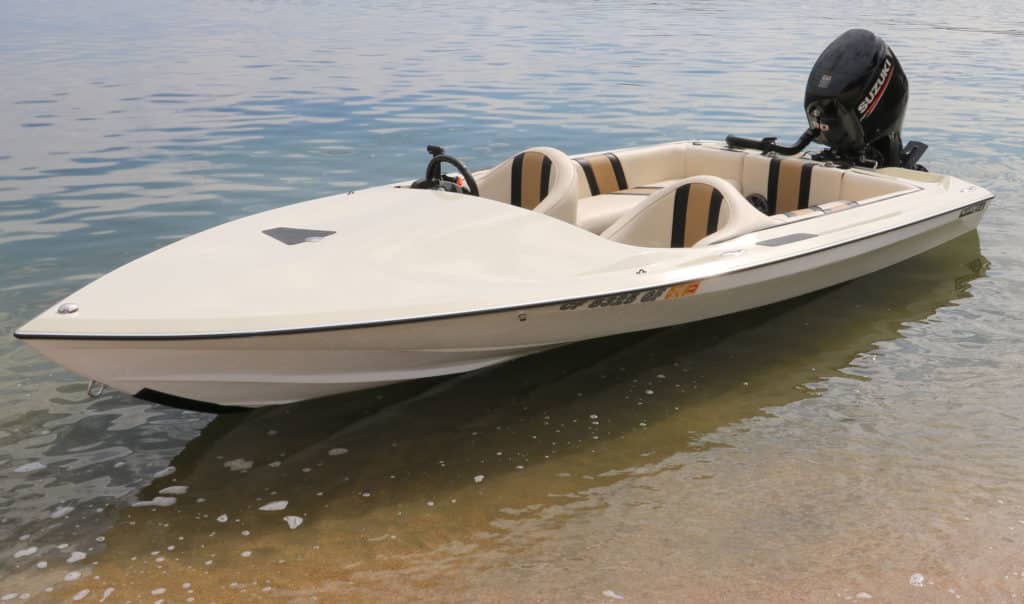
Re-upholstering a boat exceeds the skill level of most DIY boaters. For this kind of project, most of us need the help of a qualified marine upholstery shop. This is especially true for a project that encompasses the total replacement of the upholstery, a task that includes the engineering and fabrication of the upholstery framework, as well as design and crafting of the fabric coverings.
Such was the case as we entered the final phase of a complete restoration of a 1977 outboard-powered 17-foot Witchcraft runabout, a project that started with gutting the interior, including the original, but now rotted, seating, side and transom panels, and other upholstery parts. For guidance on how to proceed with replacing the upholstery, we turned to Sunbrella Horizon, which offers a broad line marine vinyl upholstery fabrics. Bill McDaniel, marine market manager for Sunbrella Horizon, offered these tips.
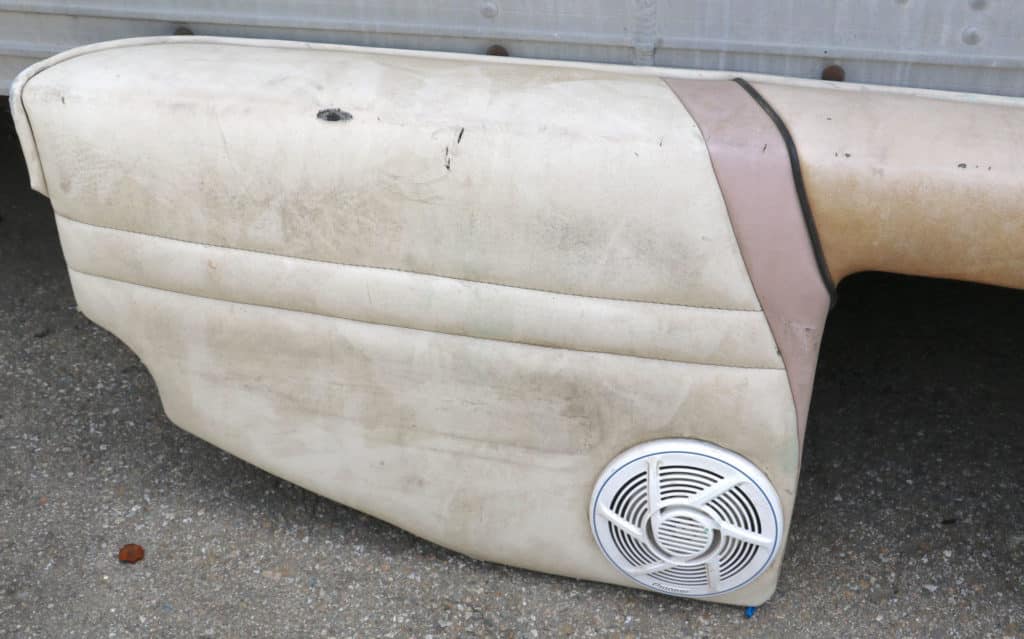
Quality Shop
As mention before, you’ll need assistance from a marine upholstery shop. But how do you find one? “A good place to start in identifying a marine upholstery fabricator is to ask local boating organizations or your marina to provide recommended partners,” McDaniel says. “Another option is to check in with the boat manufacturer or dealer.” While these sources may not always be able to do the work themselves, they can likely point you in the direction of a trusted partner shop or local fabricator.
“Also, don’t forget online resources including social media and review websites such as Yelp where you can find testimonials and past experiences from other customers,” McDaniel adds. In our case, we chose SoCal Upholstery in Montclair, California. While the shop was about 40 miles away, it came highly recommended by a number of boat dealers, as well as local boat builders, for quality design and fabrication.
Key Questions
Before work starts on your boat upholstery project, it’s important to ask the right questions to be sure the fabricator understands your goals and you know exactly what you to expect, McDaniel points out. He suggests start with questions such as:
- Can you walk me through your fabrication process?
- Are you able to assist with design?
- How long do you estimate it will take to complete the work?
- Have you worked on this type of craft before?
- What type of information is most helpful for me to provide throughout the process?
- Do you provide any type of warranty on the work?
Following the discussion, request a written or documented estimate and ask questions about what is included in the quote and what factors could affect it before you sign off on the project, McDaniel says.
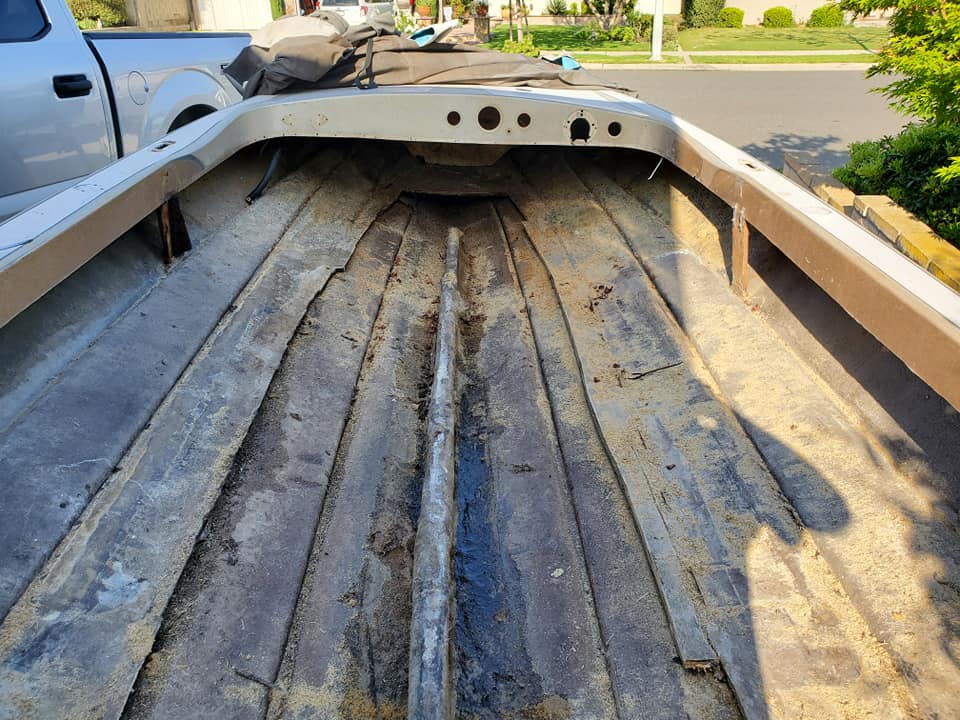
Framework: Re-use or Replace?
Whether or not the existing upholstery framework can be used will depend primarily on the reason for re-upholstery and the overall state of the boat. “It also may depend on which part of the boat you are updating,” McDaniel explains. “In many cases, it’s possible to apply new marine fabrics on an existing frame; however, you will want to be sure there is no damage or underlying issues.”
It’s important to have the framework inspected by an expert, so be sure to bring this up with your fabricator. Just like a home or building, having the right foundation is essential for long-term use and enjoyment. In our case, we decide that the old wood frame work was 45 years old and rotting, so we decided have the shop build all new frames.
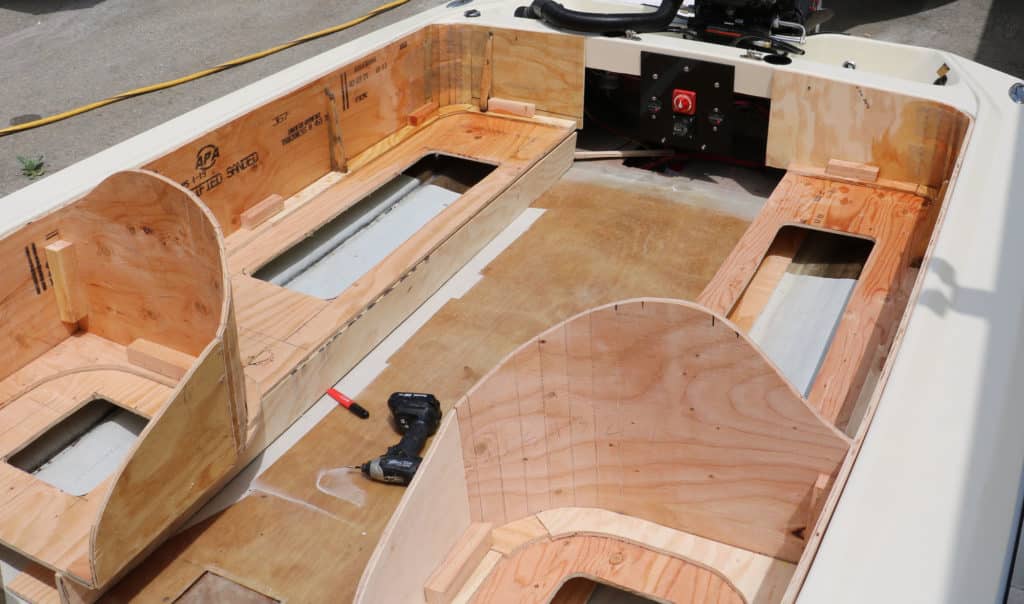
Frame Material
The material used for upholstery framework will depend on the type of boat, the craft’s age, the original materials, and your fabricator’s preferences. Framing the structure for a captain’s chair or helm chair is a different application than framing for main seating areas, such as the bow area. Typically, specialty woods like mahogany or teak are used for captain’s or helm chair structures. “Be sure to discuss your options with your fabricator partner before starting the project,” McDaniel advises. In our case, we chose plywood, which was coated with resin after construction to prevent water damage in the future.
Staple Supply
“Quality staples play an important part in marine upholstery work, alongside a strong framing material, quality fabric, the right foam cushioning and durable thread and adhesives,” McDaniel points out. In our case, we asked the fabricator to use stainless-steel staples to help prevent corrosion.
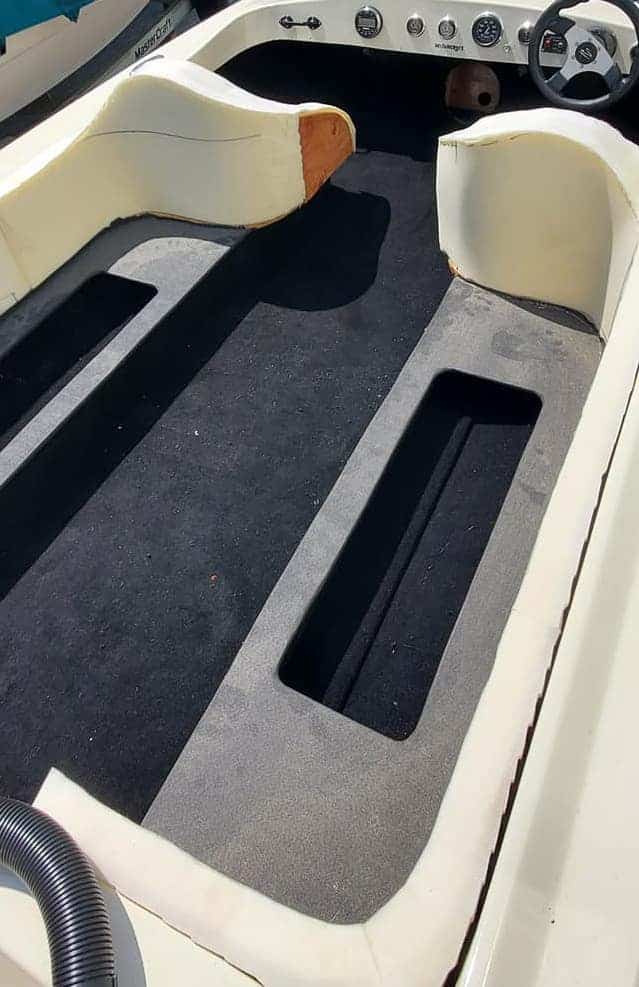
Colors and Design
Most fabricator include the design and color selection as part of their prices. “To make sure you’re happy with the outcome, it’s important to brief your shop about the goals of your project and the desired look for your boat,” McDaniel says. “Inspirational photos are especially helpful in providing a starting point.” Don’t forget to share the ideal look and feel for your boat seating along with examples of how you commonly use your boat, such as fishing or entertaining.
You will also want to discuss your goals for the entire look of the boat and where you want coordinating materials to be used, McDaniel adds. “For example, Sunbrella offers most marine fabric in matching colorways, meaning it’s easy to coordinate new upholstery fabric with existing fabric you plan to keep or other fabric on the boat, such as a Bimini top,” he points out. Using your input as well as the background on your boat and their expertise, your fabricator will be able to make smart fabric recommendations. From there you can work together to fine-tune the design before work begins, as we did with our restoration project.
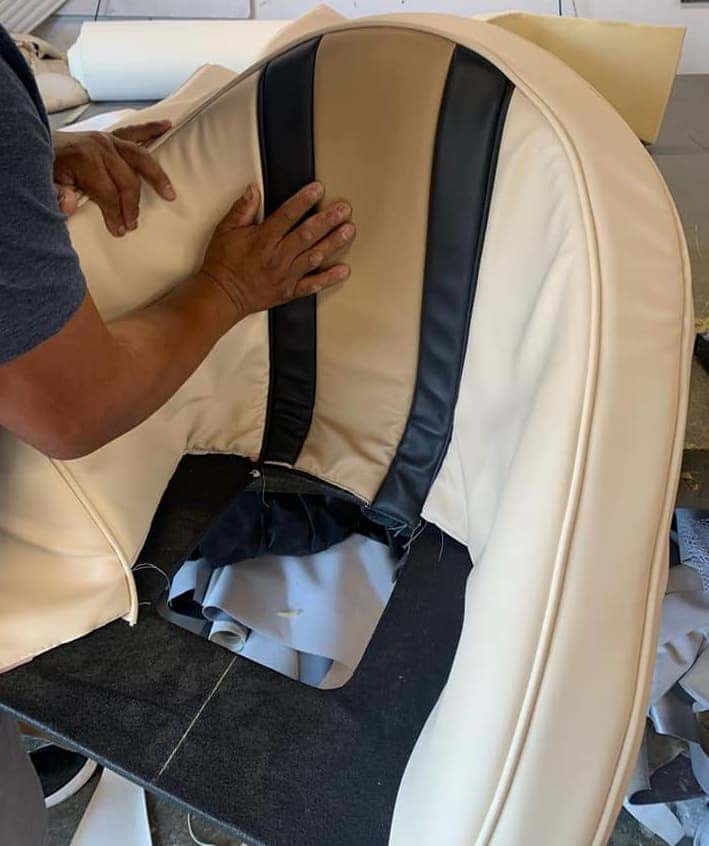
Fabric Brand
Should you specify the marine vinyl fabric brand or trust the fabricator to select it? “You and your fabricator should work together to select the right fabrics for your boat,” says McDaniel. “Like any good partnership, it’s a team effort. We always advise boaters to lean on their fabricators for recommendations but also ask questions and explore options before making a purchase decision.
“Fabricators take great pride in their work and the process should be fun,” he adds. “Treat them as a partner, get involved and you’ll get great counsel and see great results.”
Fabric Quality
When considering a marine upholstery vinyl fabric, boaters should think about quality, longevity, design and support, according to McDaniel. “Investing in a high-quality fabric will give you the peace of mind to enjoy your boat upholstery without worrying about harsh marine conditions or potential damages or spills,” he explains. The investment upfront means longer lasting boat seating, and limiting the need for costly replacements that might put your boat out of commission for long stretches of time.”
McDaniel also points out the need to care for and maintain any marine upholstery. “Make sure the fabric you select comes with support after purchase, including care and cleaning resources and comprehensive warranties,” he says. “Sunbrella fabrics are the most trusted and preferred choice and are backed by the most comprehensive warranties in the industry.
“For example, Sunbrella Horizon marine vinyl is backed by a five-year warranty that covers replacement fabric and labor costs, along with a three-year warranty against bacterial pink staining.”
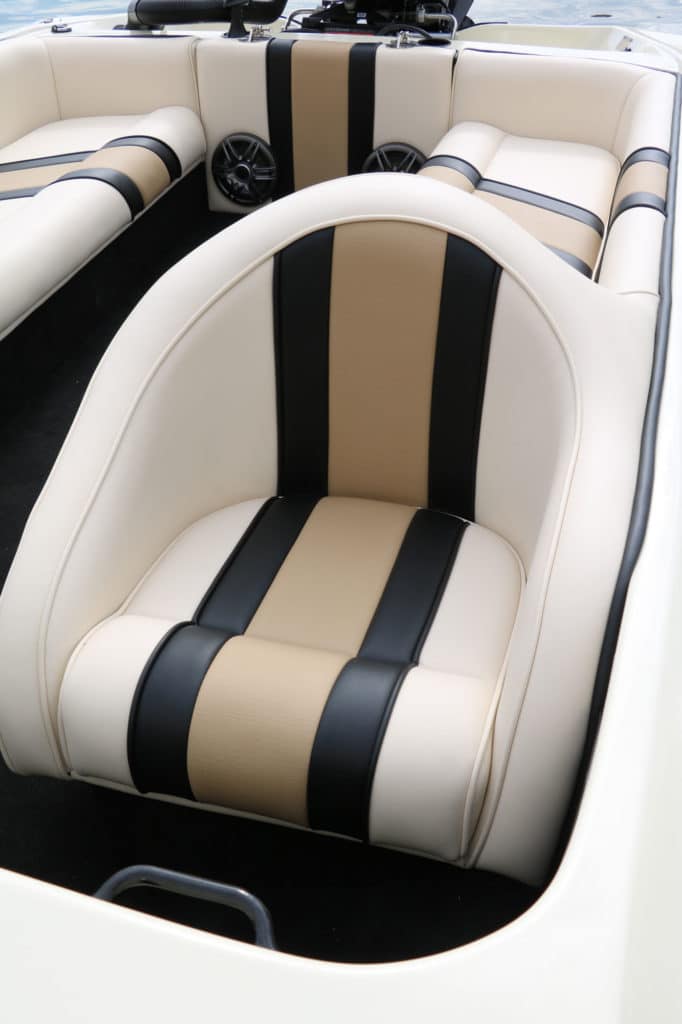
Marine Foam
When it comes to upholstery foam, good fabricators typically have a few types of foam on hand in a variety of densities to be sure they’re using the best material for the job, McDaniel says. These foams include polyurethane, Dryfast and closed cell foams. “Foam is an important element for seating, providing support and flexibility allowing for all-day comfort,” he explains. “Ask your fabricator about the foam type and density they recommend for your boat and why.”
Thread Choices
Polyester, nylon and monofilament threads each have unique benefits that could make them the right fit for your craft, and good fabricators know which to use, as well as where and when. “Like fabric, thread serves a functional and stylistic role,” McDaniel reveals. “Talk to your fabricator about contrasting thread colors, piping styles and patterns they can sew into your seating for an even more custom look.”
Ultimately, re-upholstery isn’t something you’ll likely do often, and the process does take time, McDaniel points out. “It’s important to start the conversation with your fabricator and plan for the upgrades and an ideal time for work to begin, as you’ll be without your boat,” he adds.
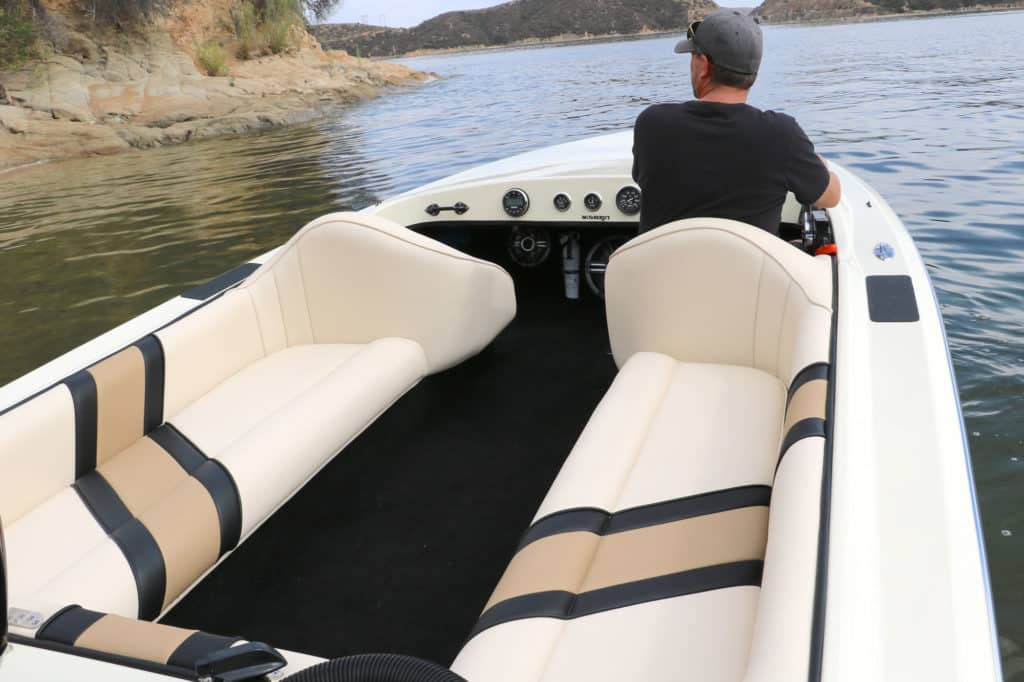
Right Attitude
“View the improvements on your boat as an investment rather than an expense, and select quality materials and crafts people to work on your boat,” McDaniel says. “This is an exciting upgrade for years of comfort and memories and taking good care of your boat now will ensure it takes good care of you and your passengers.”









